As one of the oldest and most widely recognized brands in music, Gibson has crafted some of the most cherished and valuable instruments of all time. Determining exactly when your Gibson specimen was made can have high stakes attached to it. A difference of only one year - sometimes even several months - can mean a four-figure difference in value.
Our hope is to make the dating process and, in turn, the valuation as easy, accurate and transparent as possible. You should be able to use this guide to determine the year of your instrument and then consult the Reverb Price Guide to find its value, all for free.
For many vintage instruments, determining the date of manufacture involves little more than running the serial number through a reference guide.
Whereas Martin guitars have been using a single, consistent numbering system since the 19th century, Gibson has used several different serial number formats since its inception in 1902, meaning that some formats and numbers overlap across decades. This makes it especially important to first identify the general era during which your instrument was made before pinning down the exact date of manufacture with a serial number.
If you know the backstory around when the instrument was purchased, this can provide some rough clues about its era. The most general physical piece of evidence on the instrument, however, is going to be the logo on the headstock.
1902 to Late-1920s
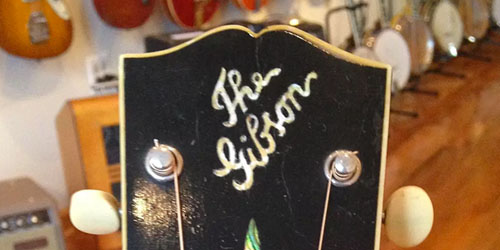
The original logo featured the words "The Gibson" inlaid in pearl at a slant, with an almost hand-written cursive font. This is sometimes referred to as the slanted script logo.
Some earlier specimens from 1903 to 1907 did not slant the logo, or went without a logo entirely. Specimens built before 1902 had a star inlay or crescent in place of a logo.
Late-1920s to 1933

The script logo continues without the slant. Some flattop guitars of this era started to omit the word "The" from the inlay.
1933 to 1947
By 1933 Gibson had dropped the "The" from all of their logos while retaining the script "Gibson." The original thin script was replaced with a thicker font on higher-end models in the mid-’30s, and across the entire lineup by the end of the decade.

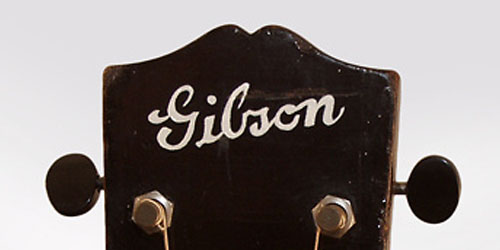

From 1943 to 1947, the logo was a thick golden script, known as the banner logo. Some models (LG-2, J-45, SJ, select L-50s) included an actual banner reading "Only a Gibson Is Good Enough" in the middle of the headstock.
1947 to Present
The block logo debuted after WWII and remains the face of the company. There were minute changes to which letters were connected in the font between 1961 to 1981, but the main logo had the same look.
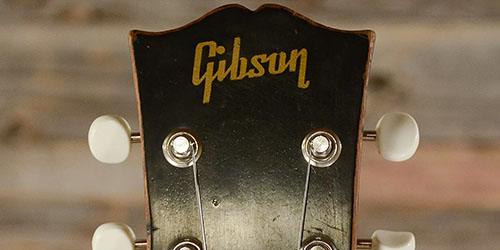
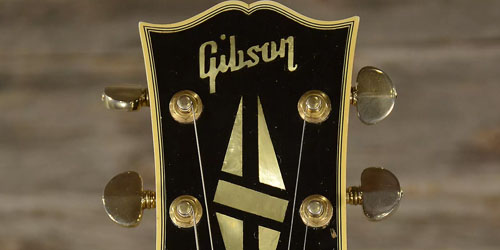
1968 to 1972
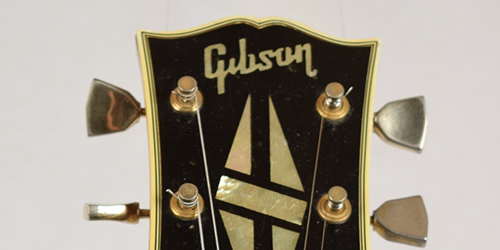
Gibson stopped dotting the i in their logo on some of their instruments. Most models get a dotted i again in 1972, with the rest following suit from 1981 onward.
Aside from the logos, each era of manufacturing included certain identifying traits such as the hardware (tuners, knobs, plates, etc.), the pickups, the type of finish, and the electronics inside that can give clues as to when an instrument was made. But not a final verdict.
Many older instruments may have reproduction or other non-original parts, including a non-original finish. This makes relying entirely on the physical features of a guitar potentially misleading.
The thickness of the headstock, however, is not as vulnerable to modification or replacement. Before mid-1950, most Gibson headstocks were thinner at the top when looked at from a side profile. After 1950, headstocks had uniform thickness.
Dating a Gibson by Factory Order Number (FON)
Gibson has historically used two different alpha-numerical formats to catalog its instruments: serial numbers and FONs (Factory Order Numbers). Instruments will generally have one or both of these numbers stamped or written either inside the body (generally the case on earlier models) or on the back of the headstock.
FONs were Gibson’s way of internally tracking batches of instruments throughout production. These will generally date an instrument earlier than the serial number, as they were typically applied in the early stages of assembly.
Some earlier lower-end models had no serial number at all, making the FON the sole numerical identifier in those cases. A FON usually consisted of a 3-, 4-, or 5-digit batch number followed by one or two other numbers in most cases.
1902 to 1945 FON Overview
| Year | FON Batch # Range |
| 1902 - 1916 | 1 to 3650 |
| 1917 - 1923 | 11000 to 12000 |
| 1924 - 1925 | 11000A to 11250A (suffix included) |
| 1925 - 1931 | 8000 to 9999 |
| 1931 - 1933 | 1 to 890 |
| 1934 | 1 to 1500 |
| 1935 | 1A to 1520A |
| 1936 | 1B to 1100B |
| 1937 | 1C to 1400C |
| 1938 | 1D to 1000D |
| 1939 | 1E to 980E |
| 1940 - 1945 | 1 to 7900 (some with letter, some without) |
From 1935 to 1942, the FON included a letter suffix. The consistency around this stopped during WWII and resumed in the early 1950s.
To complicate matters further, there was sometimes a second letter from 1938 to 1941 indicating the brand (G for Gibson, K for Kalamazoo, W for Recording King) and sometimes even a third letter indicating "Electric" (the letter E). The year is indicated by the first letter in any series of letters for these years.
1935 to 1942 FON Letter Suffixes
| Year | FON Letter Suffix |
| 1935 | A |
| 1936 | B |
| 1937 | C |
| 1938 | D, DA |
| 1939 | Ex (x being any other letter) |
| 1940 | F, FA |
| 1941 | E (with no other letters) |
| 1941 | G |
| 1942 | H |
Throughout the war and even for some time after, each year had its own quirks around FON batch numbers and letters
1942 to 1951 FON Info
| Year | FON or Letter Code |
| 1942 | 907, 910, 923, 2004, 2005, 7000s (all with banner logo) |
| 1943 | 9xx to 22xx |
| 1944 | 22xx to 29xx (some without FONs) |
| 1945 | 1xx to 10xx (many without FONS) |
| 1947 | 700s to 1000s |
| 1948 | 1100s to 3700s (move from script to block logo) |
| 1949 | 2000s |
| 1950 | 3000s to 5000s |
| 1951 | 6000s to 9000s |
From 1952 to 1961, a consistent letter code resumed, with the letter appearing before the batch number.
1952 to 1961 FON Letter Prefixes
| Year | FON Letter Prefix |
| 1952 | Z |
| 1953 | Y |
| 1954 | X |
| 1955 | W |
| 1956 | V |
| 1957 | U |
| 1958 | T |
| 1959 | S |
| 1960 | R |
| 1961 | Q |
Acoustics and Electric Archtops 1902-1961
1902-1947
Gibson’s earliest serialization system was more or less sequential, where each new instrument was assigned the next highest available number. Below is a table of the the highest known number for each production year.
| Year | Last Numbers |
| 1903 | 1150 |
| 1904 | 1850 |
| 1905 | 2550 |
| 1906 | 3350 |
| 1907 | 4250 |
| 1908 | 5450 |
| 1909 | 6950 |
| 1910 | 8750 |
| 1911 | 10850 |
| 1912 | 13350 |
| 1913 | 16100 |
| 1914 | 20150 |
| 1915 | 25150 |
| 1916 | 32000 |
| 1917 | 39500 |
| 1918 | 47900 |
| 1919 | 53800 |
| 1920 | 62200 |
| 1921 | 69300 |
| 1922 | 71400 |
| 1923 | 74900 |
| 1924 | 80300 |
| 1925 | 82700 |
| Year | Last Numbers |
| 1926 | 83600 |
| 1927 | 85400 |
| 1928 | 87300 |
| 1929 | 89750 |
| 1930 | 90200 |
| 1931 | 90450 |
| 1932 | 90700 |
| 1933 | 91400 |
| 1934 | 92300 |
| 1935 | 92800 |
| 1936 | 94100 |
| 1937 | 95200 |
| 1938 | 95750 |
| 1939 | 96050 |
| 1940 | 96600 |
| 1941 | 97400 |
| 1942 | 97700 |
| 1943 | 97850 |
| 1944 | 98250 |
| 1945 | 98650 |
| 1946 | 99300 |
| 1947 | 999999 |
1947-1961
When the original serial system reached 999,999 in 1947, Gibson started over with an ‘A’ prefix
| Year | Last Numbers |
| 1947 | A 1305 |
| 1948 | A 2665 |
| 1949 | A 4410 |
| 1950 | A 6596 |
| 1951 | A 9420 |
| 1952 | A 12460 |
| 1953 | A 17435 |
| Year | Last Numbers |
| 1954 | A 18665 |
| 1955 | A 21910 |
| 1956 | A 24755 |
| 1957 | A 26820 |
| 1958 | A 28880 |
| 1959 | A 32285 |
| 1960 | A 34645 |
Solid Body Electrics 1952-1961
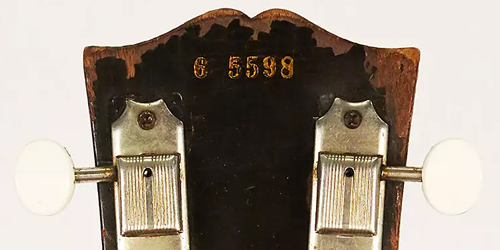
Early Gibson solidbody electrics received a serial stamp on the back of the headstock, with the first number indicating the year of production. The serial number on this Les Paul Junior indicates that it was made in 1956.
1961-1969
Starting in 1961, Gibson implemented a new serialization system designed to cover its entire lineup. However, while the intent was to maintain a more organized catalog, this system in practice achieved the exact opposite.
Numbers from this era were flipped, reused, and in many cases can date an instrument to several non-sequential years. The general system was as follows, though with instruments from this era it’s important to consult key features to get a more accurate age approximation.
Fortunately, Gibson was making more changes to its instruments during the ‘60s and ‘70s than any other period, so dating these instruments by features alone is relatively clear-cut in most cases.
| Year | Approx Serial Range |
| 1961 | 100-42440 |
| 1962 | 42441-61180 |
| 1963 | 61450-64220 |
| 1964 | 64240-70500 |
| 1962 | 71180-96600 |
| 1963 | 96601-99999 |
| 1967 | 000001-008010 |
| 1967 | 010000-042900 |
| 1967 | 044000-044100 |
| 1967 | 050000-054400 |
| 1967 | 055000-063999 |
| 1967 | 064000-066010 |
| 1967 | 0670000-070910 |
| 1967 | 090000-099999 |
| 1963, 1967 | 100000-106099 |
| 1963 | 106100-108900 |
| 1963, 1967 | 1090000-109999 |
| 1963 | 110000-111549 |
| 1963, 1967 | 111550-115799 |
| 1963 | 115800-118299 |
| 1963, 1967 | 118300-120999 |
| 1963 | 121000-139999 |
| 1963, 1967 | 140000-140100 |
| 1963 | 140101-144304 |
| 1964 | 144305-144380 |
| 1963 | 144381-145000 |
| 1963 | 147009-149864 |
| 1964 | 149865-149891 |
| 1963 | 149892-152989 |
| 1964 | 152990-174222 |
| 1964, 1965 | 174223-176643 |
| 1964 | 176644-199999 |
| 1964 | 200000-250335 |
| 1965 | 250336-291000 |
| 1965 | 301755-302100 |
| 1965 | 302754-305983 |
| 1965, 1967 | 306000-306100 |
| 1965, 1967 | 307000-307985 |
| 1965, 1967 | 309848-310999 |
| 1965 | 311000-320149 |
| 1967 | 320150-320699 |
| Year | Approx Serial Range |
| 1965 | 320700-321100 |
| 1965 | 322000-326600 |
| 1965 | 328000-328500 |
| 1965 | 328700-329179 |
| 1965, 1967 | 329180-330199 |
| 1965, 1967-68 | 330200-332240 |
| 1965 | 332241-327090 |
| 1965 | 348000-348092 |
| 1966 | 348093-349100 |
| 1965 | 349121-368638 |
| 1966 | 368640-369890 |
| 1967 | 370000-370999 |
| 1966 | 380000-385309 |
| 1967 | 390000-390998 |
| 1965-68 | 400001-400999 |
| 1966 | 401000-407985 |
| 1966 | 408000-408690 |
| 1966 | 408800-409250 |
| 1966 | 420000-426090 |
| 1966 | 427000-429180 |
| 1966 | 430005-438530 |
| 1966 | 438800-438925 |
| 1965-66, 1968-69 | 500000-500999 |
| 1965 | 501010-501600 |
| 1968 | 501601-501702 |
| 1965, 1968 | 501703-502706 |
| 1968 | 503010-503110 |
| 1965, 1968 | 503405-520955 |
| 1968 | 520956-530056 |
| 1966, 1968-69 | 530061-530850 |
| 1968-69 | 530851-530993 |
| 1969 | 530994-539999 |
| 1966, 1969 | 540000-540795 |
| 1969 | 540796-545009 |
| 1966 | 550000-556910 |
| 1969 | 558012-567400 |
| 1966 | 570099-570755 |
| 1969 | 580000-580999 |
| 1966-69 | 600000-600999 |
| 1969 | 601000-601090 |
| 1969 | 605901-606090 |
| Year | Approximate Serial Range |
| 1966-67 | 700000-700799 |
| 1968-69 | 750000-750999 |
| 1966-69 | 800000-800999 |
| 1966, 1969 | 801000-812838 |
| 1969 | 812900-814999 |
| 1969 | 817000-819999 |
| 1966, 1969 | 820000-820087 |
| 1966 | 820088-823830 |
| 1969 | 824000-824999 |
| 1966, 1969 | 828002-847488 |
| 1966 | 847499-858999 |
| 1967 | 859001-880089 |
| Year | Approximate Serial Range |
| 1967 | 893401-895038 |
| 1968 | 895039-896999 |
| 1967 | 897000-898999 |
| 1968 | 899000-899999 |
| 1968 | 900000-902250 |
| 1968 | 903000-920899 |
| 1968 | 940000-941009 |
| 1968 | 942001-943000 |
| 1968 | 945000-945450 |
| 1968 | 947415-956000 |
| 1968 | 959000-960909 |
| 1968 | 970000-972864 |
1970-1975
Despite being purchased by the Norlin corporation in 1970, Gibson maintained the same confusing 6-digit serial system through 1975, meaning instruments with the same serial number could be from either the ‘60s or the ‘70s.
Fortunately, there were two notable changes to the entire lineup that occurred during the transition that make differentiating ‘60s and ‘70s Gibsons straightforward.
The Volute: c. 1969-c.1981
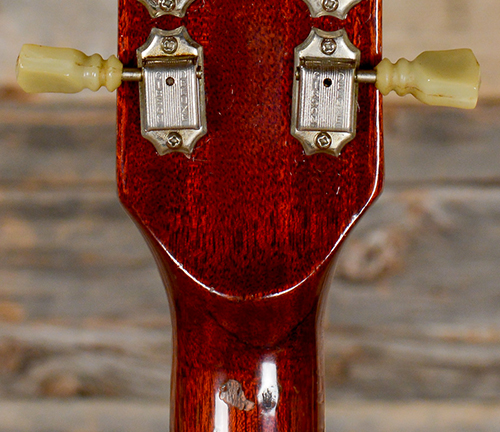
In 1969 Gibson began carving volutes-- small bumps of additional wood where the neck transitions to the headstock-- to cut down on warranty repair work.
"Made in USA" Stamp: 1970-current
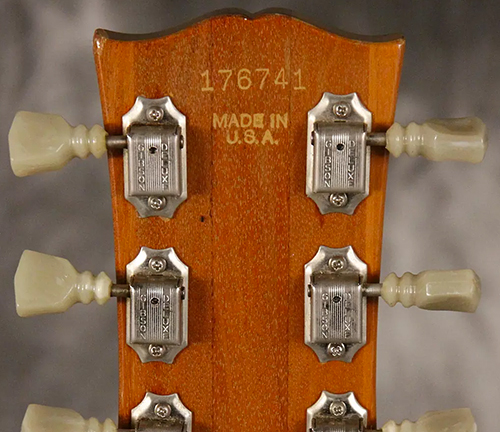
Starting in 1970, ‘Made in USA’ was stamped on the headstock below the serial number.
The serial numbers from this period are generally as follows:
| Number | Year |
| 000000S | 1973 |
| 100000S | 1970-1975 |
| 200000S | 1973-1975 |
| 300000S | 1974-1975 |
| 400000S | 1974-1975 |
| 500000S | 1974-1975 |
| 600000S | 1970, 1971, 1972, 1974, 1975 |
| 700000S | 1970, 1971, 1972 |
| 800000S | 1973, 1974, 1975 |
| 900000S | 1970, 1971, 1972 |
1975-1977
| Number | Year |
| 99XXXXXX | 1975 |
| 00XXXXXX | 1976 |
| 06XXXXXX | 1977 |
1977-Current
Starting in 1977, Gibson adopted the current date-based serial system which codes for the year and day of production. The first number of the sequence indicates the decade of production, followed by the three digit day of the year, and finally the year.
For example, the serial number 90237XXX corresponds to a production date of 1/23/97. The last three (or four as of 2005) digits signify the location of production and batch number, respectively, but this information isn’t necessary to accurately dating your instrument.
Working with a potentially very valuable old Gibson can be intimidating, particularly for someone who doesn’t have experience with vintage instruments. If you feel like your guitar could be highly valuable or just want as much information as possible, we recommend finding an official appraiser or reach out to a Gibson representative.
